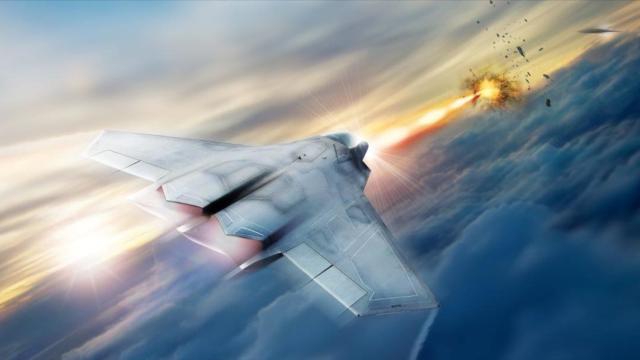The US Air Force’s scientific research wing is giving Lockheed Martin $US26.3 million ($34.3 million) “for the design, development, and production of a high power fibre laser” which it expects to start testing on a tactical fighter jet in four years. Sounds cool and certainly futuristic, but the jury’s still out on whether these weapons have any real tactical value.
It sounds like science fiction, but lasers – formally known as “directed-energy weapons” – have been used by the US Army’s ground forces for years. But now, the Pentagon’s Air Force Research Lab (AFRL) wants to take the next step and give these seemingly futuristic weapons a set of wings. As announced earlier this week, Lockheed Martin was awarded the contract as part of AFRL’s Self-protect High Energy Laser Demonstrator (SHiELD) program.
“Lockheed Martin continues to rapidly advance laser weapon systems and the technologies that make them possible,” said Rob Afzal, a Lockheed laser weapons expert, in a statement. “We have demonstrated our ability to use directed energy to counter threats from the ground, and look forward to future tests from the air as part of the SHiELD system.”
Earlier this year, Lockheed unveiled a 60 kilowatt-class laser that can be installed on trucks, such as the Heavy Expanded Mobility Tactical Truck – the US Army’s largest ground vehicle. But now Lockheed has to make a laser that can be installed onto a fighter jet – no small task given that laser systems tend to be big and heavy. They’re also energy hogs that need to cooled both during and after use. The new laser will need to work in a tight, compact environment, and be immune to the effects of vibrations, temperatures and tremendous G forces. At the same time, the system cannot impair aeronautic performance.
“It’s a completely new and different challenge to get a laser system into a smaller, airborne test platform. It’s exciting to see this technology mature enough to embed in an aircraft,” said Afzal. “The development of high power laser systems like SHiELD show laser weapon system technologies are becoming real. The technologies are ready to be produced, tested and deployed on aircraft, ground vehicles and ships.”
Image: Air Force Research Lab
The SHiELD program itself consists of three different components, all of which are being designed and developed by different manufacturers. Northrop Grumman is currently at work on the beam control system, called STRAFE, which will be used to direct the laser to the target. Boeing is current developing a pod that will be mounted on the fighter jet to power and cool the laser, and Lockheed Martin is working on LANCE – the high energy laser itself. Once all these components are brought together, and as part of the SHiELD program, AFRL will test the capabilities of a laser-equipped fighter jet to defend itself from the air or ground.
Lockheed did not disclose the power of the pending laser weapon, but did say it will be in the “tens of kilowatts” range. And as reported in Defence News, it also isn’t known which fighter jet will carry the laser or how the Air Force will test the weapon during the 2021 demos.
At an initial $US26.3 million ($34.3 million) price tag, it’s reasonable to ask if an extravagant weapon such as this is even worth it. Fighter jets already have an assortment of air-launched weapons, including conventional bombs, missiles (including ground-to-air missiles), and even torpedoes. Lasers (as already noted) require a tremendous amount of energy, they have a short range, and they suck in settings where there’s haze, smoke and dust.
“Lasers are no substitute for guns and missiles,” according to an analysis put out earlier this year by the Strategic Culture Foundation. “They can add to the defensive capabilities but cannot be used as primary strike weapons.”
But the US War Machine is a hungry beast, and futuristic-sounding weapons are an easy sell – even if they are redundant, limited in scope, and often ineffective.
